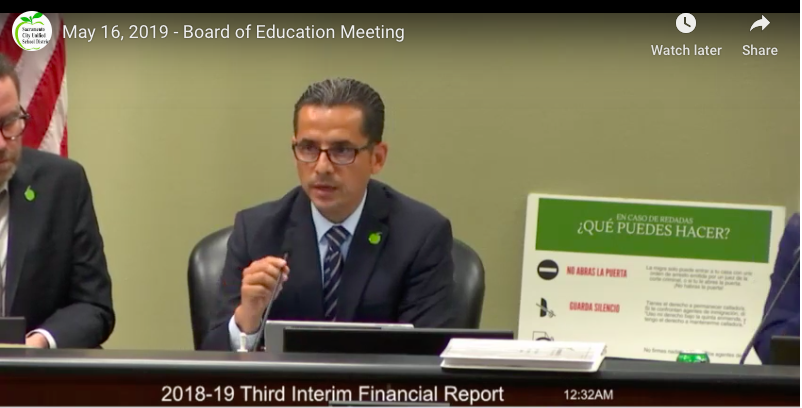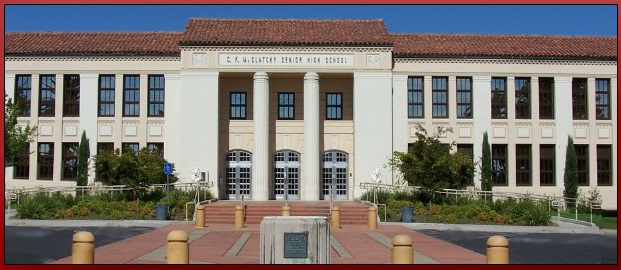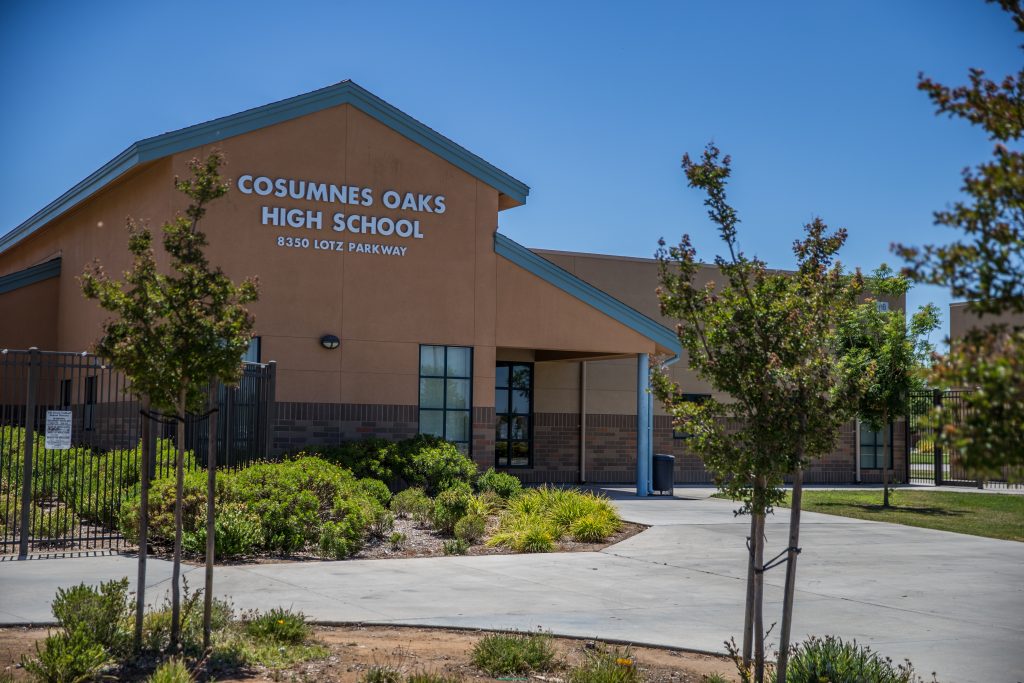
SCUSD Superintendent Jorge Aguilar. (Photo: SCUSD.org)
Sacramento City School District At Tipping Point: Insolvency Next Year
Employee salary and benefits represented most of the district’s budget
By Katy Grimes, December 10, 2019 12:10 pm
California’s State Auditor recently reported that the Sacramento City Unified School District is facing insolvency as early as next year. “Because It Has Failed to Proactively Address Its Financial Challenges, It May Soon Face Insolvency,” the auditor wrote.
The primary cause and effect is as the teachers union maintains complete control of the budget, “Sacramento Unified has not proactively addressed its financial problems and is close to insolvency—it projects facing a $19.1 million shortfall in fiscal year 2021–22.”
The Auditor reported:
The Sacramento City Unified School District serves about 41,000 students and employs 2,200 teachers. Since fiscal year 2016–17, its expenditures have exceeded its ongoing revenue by $9 million to $25.9 million each year.
During this same time period, it has increased spending in three main areas—teacher salaries, employee benefits, and special education—without taking sufficient action to control these costs.
“When you read the audit, you think to yourself, ‘this wouldn’t fly in my homeowners association!” said Robert Fellner with Transparent California in a California Globe interview. “This is a major, major school district. Everyone was aware of the problems. The Sacramento County office of Education warned them repeatedly.”
Sacramento City Unified to face insolvency next year, as teachers union maintains complete control of the budget.
The school will face a $19 million budget shortfall next year, and has no plan for how to pay their bills. https://t.co/rZlY5Ynmbb
— Transparent California (@Transparent_CA) December 10, 2019
“California parents need to wake up; the teachers union is not your friend.”
“At the board meeting to approve the labor contract in December 2017, the Sacramento County superintendent of schools informed the board that Sacramento Unified could not afford the agreement unless it reduced its budget by $15.6 million,” the Auditor wrote.
But as Fellner says, everyone also deferred to the teachers union. “The Sacramento Superintendent said he didn’t want to have to deal with a teachers union strike,” Fellner added.
This isn’t exactly new news. In March, California Globe reported:
“The Sacramento City Unified School District is teetering on insolvency. Even with these financial warning signs, after the Sacramento City School District ended the 2017-18 fiscal year with an $11 million deficit and just days after Superintendent Jorge Aguilar submitted the 2018-19 budget projecting another $22 million deficit (which was rejected by the county), Aguilar and seven other administrators spent more than $35,000 to attend a six-day conference at the Harvard Business School, the SCTA reported.”
The Sacramento City Unified School District is projected to run out of cash by November 2019 unless steep cuts are made, the Bond Buyer reported. “Sacramento City “entered into a collective bargaining agreement in December 2017 that they could not afford. The Fiscal Crisis & Management Assistance Team report released in December concluded that SCUSD needed to make $35 million in cuts by the time it adopted its 2019-20 budget or it would only have three to four months of cash remaining for day-to-day operations.”
“The teachers union has been so successful in putting their needs ahead of the students,” Fellner said. “California parents need to wake up; the teachers union is not your friend.”
The audit shows that the teachers union pushed for 15% pay raises. But as Fellner said, the union claimed their pay was actually lower than other districts, somehow justifying the huge pay increase. “They vilify us for showing total compensation in our reports, but total compensation is the only number that matters,” he said.
The Auditor explains:
“This labor agreement could ultimately cost Sacramento Unified about $31 million per year in additional costs, an increase of 5 percent in the district’s total spending in fiscal year 2019–20. At the time of the labor negotiations, the teachers union believed that the district’s fund balance was steadily increasing and that teacher salaries were relatively low. However, neither of these beliefs was entirely accurate. Although Sacramento Unified did have lower average teacher salaries than comparable school districts before the 2017 agreement, it consistently maintained the highest average total compensation for teachers because it offered more generous and expensive health care benefits. Further, at the time of the labor negotiations, Sacramento Unified had received one-time funds from the Legislature that likely gave the impression that the district was in better financial condition than it actually was. However, the Legislature allocates one-time funds for a specific purpose, such as satisfying potential outstanding state mandate claims, and for a limited term. Consequently, school districts should not rely on them for ongoing expenses, like teacher salaries.”
“They can’t have it both ways,” Fellner said, “rich lifetime benefits and high salaries.”
While Sacramento City School District Employee benefits represented almost a third of the district’s budget, the Auditor said other nearby school districts typically pay for the lowest cost health plan for the employee and their family or pay the full cost for only the employee’s health care.

At a May 2019 Board of Education meeting, Sacramento City Board members discussed on camera “.91 cents of every dollar is spent on salary and benefits,” with only .9 cents going to programs. The Board acknowledged that David Gordon, Superintendent of the Sacramento County Office of Education, warned the District for 14 years that their practices were unsustainable. (video, 5:38:20)
Fellner said that this is happening in one of the strongest economies the country and State of California have ever seen. “But by the next recession, they will claim ‘we need to make cuts due to the recession,’ which is baloney.”
California got into this public pension and benefits mess in 1999 when then-Gov. Gray Davis signed Senate Bill 400 by state Sen. Deborah Ortiz (D-Sacramento), which retroactively increased public pensions 50% for California Highway Patrol officers.
“That began a stampede of similar increases across California for other peace officers, firefighters and public employees in state and local governments,” Sen. John Moorlach (R-Costa Mesa) explains. “The argument often was made that the benefit had to be granted or local workers would shift to more generous neighboring governments that already had goosed their pensions.”
Lawmakers and Governor Davis were warned by the non-partisan Legislative Analyst’s Office, fiscal consultants in the Capitol, business groups, college professors, and some in local governments like Sen. Moorlach, who brought Orange County out of bankruptcy as the County Treasurer.
Moorlach said, “I’ve been a public official emphasizing prudent use of the public purse since I became Orange County’s treasurer-tax collector in 1995, after the county’s 1994 bankruptcy, which I had warned might happen.”
“Although recessions, including the Great Recession, are not predictable precisely, what is predictable is that eventually the business cycle goes down as well as up,” Moorlach said. “There will be rough patches that need to be guarded against as much as possible through prudent financial management, especially when the public’s tax dollars are at stake.”
Teachers union pushes Sacramento City Unified to insolvency, school has no plan for how to pay its bills next year:https://t.co/rZlY5Ynmbb pic.twitter.com/JNddXxGpLO
— Transparent California (@Transparent_CA) December 10, 2019
In an op ed for California Globe in January, Sen. Moorlach predicted Sacramento City School District’s financial crisis. “I’m not surprised,” Moorlach said. “It was one of the lowest-ranked among the 944 school districts I analyzed in my October 3, 2018 report, ‘Financial Soundness Rankings for California’s Public School Districts, Colleges & Universities.’ The report found two-thirds of state school districts ‘bleed red ink.’”
“The financial problems of these districts have worsened despite leaps in spending. For example, according to Sacramento City Unified’s 2017 CAFR (the same one I used for my report), Total Government Funds revenues were $647 million, up 40 percent from the $461 million on the 2010 CAFR.”
“Another way to look at CAFR numbers is the per capita UNP, based on the number of residents in a school district, as provided by the California Department of Education.”
“That also rang an alarm bells for Sacramento City Unified, at ($1,588) per capita, 867th worst among the 944 California public school districts.”
However, as Fellner notes, “the short-term politicians… some of them don’t want to know.” The few politicians, fiscal consultants and college professors like Joe Nation of Stanford (and a Democrat), and Sen. Moorlach, who do know and have been warning of financial collapse and school district insolvency, “they get destroyed by the unions. They are vilified.”
Read the full audit HERE.
(Transparent California is California’s largest and most comprehensive database of public sector compensation and is a project of the Nevada Policy Research Institute, a nonpartisan, free-market think tank… not a California think tank, but a Nevada think tank. Learn more at TransparentCalifornia.com.)
- American Freedom isn’t Achieved Through Commie Mamdani’s NYC or Comrade Newsom’s California - January 5, 2026
- California’s Open-Carry Gun Ban Struck Down by Ninth Circuit - January 3, 2026
- Sable Pipeline Gets Go-Ahead to Restart California Pipeline - January 2, 2026



